

A report by the National Council of Juvenile and Family Court Judges (NCJFCJ) has found that additional improvements in data collection and collaboration between courts and public agencies are required to better meet the unique needs of American Indian/Alaska Native (AI/AN) children in court dependency cases. The study also found that AI/AN children and their families need more effective representation in court and that courts need to exercise greater oversight to achieve these goals.
The report, NCJFCJ annual conference, held July 12–15 in Chicago.
Partially funded by OJJDP through the Model Dependency Courts Initiative, the report provides a preliminary examination of recommendations made in a 2004 study by the Pew Commission on Children in Foster Care, focusing on State and tribal court involvement in Indian child welfare matters and opportunities for enhancing court systems for the betterment of AI/AN children.
In its study, entitled "Fostering the Future: Safety, Permanence and Well-Being for Children in Foster Care," the Pew Commission outlined four areas in which substantial court improvement was required: data collection, training and collaboration, improving legal representation, and court operation. The Commission's recommendations have garnered considerable attention and ensuing action on the part of government leaders, State juvenile dependency courts, and child welfare agency personnel and tribes. The recommendations have proven vital to court reform and improving outcomes for AI/AN children.
The new NICWA–NCJFCJ report offers additional recommendations to strengthen the foster care system's response to the needs of AI/AN children. It provides an overview of some of the challenges and promising practices gleaned from tribal-State collaborations in the four areas of court improvement outlined by the Pew Commission. The report emphasizes that AI/AN children have a unique political status as citizens of sovereign nations, and that these nations are inherently best equipped to identify, understand, and respond to their needs. Specifically, the report explains that most dependency cases of AI/AN children are referred to State courts because tribal courts have significantly less access to Federal funds than do States, and therefore cannot provide the same level of services. However, State courts usually lack knowledge about tribal culture and a familiarity with the Indian Child Welfare Act to address AI/AN child welfare needs.
The report concludes that, although tribal-State partnerships have yielded many positive developments in some of the above referenced areas, much remains to be done to improve outcomes for AI/AN children and families involved in juvenile dependency proceedings. The supplemental recommendations detailed in the report build on those of the Pew Commission and apply specifically to the needs of AI/AN children.
These recommendations include focusing additional attention on processes that support improved outcomes for AI/AN children in the State foster care system; making additional Federal funding (comparable to that of State Court Improvement Program grants) available to tribes so that they can establish and further develop their capacity to hear AI/AN child welfare cases; and collaboratively developing culturally tailored training and technical assistance and making this assistance available to State courts, child welfare agencies, and tribes to improve outcomes for AI/AN children.
OJJDP's support of the report is only one example of the Office's comprehensive commitment to ensuring a safer, healthier future for AI/AN children. OJJDP administers the Tribal Youth Program, which supports tribal efforts to prevent and control delinquency and improve tribal juvenile justice systems for AI/AN youth. Since fiscal year 1999, OJJDP has awarded 321 grants to 299 federally-recognized tribes to help them develop and implement culturally sensitive programs, interventions for court-involved tribal youth, improvements to the tribal juvenile justice system, alcohol and drug abuse prevention programs, and mental health program services. See the article "TYP Grant Provides American Indian Youth Glimpse of State Legislature" for a description of how a recent TYP grant has made a difference in the lives of tribal youth in Oregon.
There is still time to register to attend OJJDP's 11th Annual National Enforcing Underage Drinking Laws (EUDL) Leadership Conference, "Beyond Boundaries: Timely Trends and Technology," which will take place August 13–14 in Dallas, TX. Registration information is available online.
Sponsored by Underage Drinking Enforcement Training Center, the conference is the premier research-based symposium on underage drinking prevention and enforcement. This year's conference will cover a broad range of topics, including technology and tools to enhance Federal, State, and local efforts; cutting-edge research and evaluation; and successful and innovative collaborations and partnerships. The conference will include guest appearances by Federal and State dignitaries, a luncheon discussion with top experts about the latest research findings on the development of the adolescent brain, general plenary sessions on lessons learned from the EUDL Leadership Institute, new research and tools for community leaders to advance EUDL work, and law enforcement experiential exercises that will instruct participants on how to conduct compliance-check and shoulder-tap operations. A youth track also is planned to hone youth skills in leadership and community action. The closing plenary will feature a youth presentation and recipients of the 2009 Success Story Awards and Rural Discretionary Recognition Awards.
Approximately 1,500 participants are expected to attend. Attendees will include law enforcement personnel, State EUDL coordinators, judges, court personnel, public officials, researchers, military officials, Federal, State, and territory partners, prevention advocates, education representatives, staff of community-based organizations, parents, and youth. In addition to offering wide-ranging and detailed information on current trends in underage drinking prevention and enforcement, the conference will provide valuable networking opportunities for professionals from across the country in various disciplines.
Registration for the EUDL conference is available through the conference Web site.
The EUDL Program
Established by OJJDP in 1998, EUDL is the only Federal initiative directed exclusively toward preventing underage drinking. The program is a $25 million initiative consisting of block grants to each State and the District of Columbia and discretionary grants to selected States to fund the best and most promising activities and research at the local level while seeking cutting-edge strategies to expand knowledge and positive outcomes. In fiscal year 2008, OJJDP allocated $350,000 in EUDL block grants to each State, territory, and the District of Columbia and funded EUDL discretionary programs in Illinois, Nevada, and South Carolina. The discretionary programs focus on reducing underage drinking on college and university campuses that are partnered with adjacent communities. Block grants support statewide task forces of State and local law enforcement and prosecutorial agencies to target establishments suspected of a pattern of violations of State laws governing the sale and consumption of alcohol by minors. The grants also support public advertising programs to educate establishments about statutory prohibitions and sanctions. Innovative programs to prevent and combat underage drinking are encouraged.
Resources:
For more information about OJJDP's EUDL program, please visit the Web page.
A group of American Indian youth in Oregon recently traveled to the Oregon Statehouse in Portland, where they observed lawmakers at work and attended a ceremony recognizing Federal tribes in the State—thanks to a grant through the Tribal Youth Program (TYP).
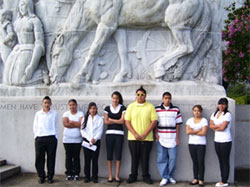
Eight TYP youth where selected to participate in the State Capital House of Representatives Page Program at the Oregon Statehouse. This was the first American Indian group in the State of Oregon to take part in the program.
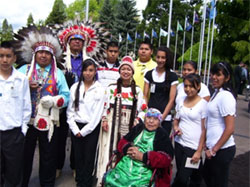
TYP youth attending Tribal Day, an event that featured nine federally recognized tribes in the State of Oregon.
To participate in the Page Program, the youth had to apply for 1-day internships. Of the 15 applicants from the Warm Springs Reservation, 8 were accepted. Their trip coincided with Tribal Day, an event that featured nine federally recognized tribes; the participants were able to meet one of the tribal chiefs, Chief Joe Moses.
For most of the youth, this was their first time in a big city, as Warm Springs, OR, is more than 100 miles from Portland. Also, the program required the participants to wear professional dress clothes, which many of the tribal youth had never purchased. In addition, the State legislative sessions are completely different than the tribal government sessions the youth had attended.
The Confederated Tribes of Warm Springs Reservation in Warm Springs, OR, received a 4-year TYP grant in 2007. The program serves about 70 youth on a reservation of more than 4,560 people. In addition to providing tutoring services, the program provides participants a connection to their tribal heritage and teaches them cultural activities such as preparing traditional tribal food.
Tribal Initiatives To Implement "Green Technologies"
Solicitations for two recently announced initiatives specifically sought service providers to implement "green technologies" and provide training and technical assistance on these activities to tribes. The solicitations—the OJJDP fiscal year (FY) 2009 Tribal Juvenile Detention and Reentry Green Demonstration Program and the OJJDP FY 2009 Training and Technical Assistance for Tribal Juvenile Detention and Reentry Green Program—mark the first time that OJJDP's tribal programs have sought to "go green" and reduce their carbon footprint.
The program seeks to implement green technologies and environmentally sustainable activities for youth residing in, or soon to be released from, tribal detention facilities. Possible activities that qualify under the scope of this initiative include indigenous and organic farming, composting, recycling programs, beekeeping, and assembling and installing solar panels and wind turbines. The activities also must be compatible with the culture of the tribe.
Both solicitations sought multiple providers. Awards will be made later this summer.
OJJDP staff met with three foreign delegations in June and July to offer lessons learned and share best practices that might be implemented in their respective countries.
- On July 8, OJJDP staff met with senior law enforcement officials from Spain to share information on strategies for preventing and addressing the sexual exploitation of children—a growing problem in that country and around the world. Included in the Spanish delegation were Roberto Fernandez (chief, Protection of Minors Unit, Spanish National Police); Juan Salom (chief, Cyber Crime Unit, Civil Guard); Javier Garcia (technical advisor, Office of the Ombudsman for the Protection of Minors, Madrid); and Luis Uriarte (prosecutor, Provincial Court, Pontevedra). OJJDP staff offered comprehensive information about the activities of the Office's Child Protection Division, AMBER Alert system, Internet Crimes Against Children task force program, and Socioeconomic Mapping and Resource Topography (SMART) system. A focal point of the discussion was the use of the Internet to monitor sex offenders, create awareness, and foster more effective communication between practitioners, researchers, law enforcement personnel, and policymakers.
- On June 19, Deputy Assistant Attorney General Mary Lou Leary, OJJDP Acting Administrator Jeff Slowikowski, and other OJJDP staff met with representatives from the British Ministry of Justice to discuss OJJDP's ongoing initiatives for preventing and intervening in juvenile delinquency. The meeting focused on OJJDP's rehabilitation programs for juvenile offenders, programs to prevent early-onset offending, and the issue of teen violence and dating/domestic violence. OJJDP offered a detailed overview of the Office of Justice Programs (OJP) and summaries of the programs and activities of OJJDP and other agencies within OJP. Future collaboration between the British Ministry of Justice and OJJDP was discussed at length, including ongoing information sharing about programs, research, juvenile justice statistics, implementation strategies, and methods for replicating successful programs.
- On June 2, OJJDP welcomed Alex Pereira Barboza, a Brazilian social activist, author, and rapper to discuss intervention, safe-space programs, and numerous other initiatives to combat juvenile delinquency in his country. OJJDP staff and interns participated in a roundtable discussion with Mr. Barboza (also known as MV Bill) and shared information from the OJJDP Model Programs Guide. Also, Mr. Barboza was pleased to learn that a current OJJDP grantee, Youth Crime Watch, a youth-led crime prevention program, has been replicated in Brazil and numerous other countries.
In July, OJJDP met with law enforcement officials from Spain to share information about the Office's broad array of programs to address the sexual exploitation of children.
Brazilian entertainer and social activist Alex Pereira Barboza, (third from left), met with OJJDP staff in early June to discuss strategies for preventing juvenile delinquency in his country.

OJJDP's State Relations and Assistance Division (SRAD) will hold its 2009 National Conference October 26–29, 2009, in Austin, TX. The conference, entitled "Ensuring Safe and Equal Treatment in the Juvenile Justice System," will address the four core requirements of the Juvenile Justice and Delinquency Prevention (JJDP) Act of 2002:
- Deinstitutionalize status offenders (DSO).
- Separate juveniles from adults in secure facilities (sight and sound separation).
- Remove juveniles from adult jails and lockups (jail removal).
- Reduce disproportionate minority contact (DMC) within the juvenile justice system.
The first two days of the conference (October 26–27) will focus on monitoring for compliance with DSO, sight and sound separation, and jail removal. Following are a few of the topics to be covered in the conference's information and training sessions: The Role of the State Advisory Group in Compliance Monitoring, Monitoring for the Core Requirements by Facility Type, Utilizing the Valid Court Order, and Compliance Monitoring Definitions: When State and Federal Laws Comport.
Attendance at this portion of the conference is by invitation only. Registration is limited to Juvenile Justice Specialists, State DMC Coordinators, compliance monitors, Juvenile Accountability Block Grants Coordinators, Title V Coordinators, State Advisory Group members, and State juvenile justice program staff.
The final two days of the conference (October 28–29) will focus on systems improvement strategies and activities to reduce DMC. Sessions will include Conducting Reliable DMC Assessments, DMC Diversion Programs, Implementing Risk Assessment Instruments (RAIs) To Reduce DMC, Effective Strategies for Systems Improvement in Rural Communities, and Promising Tribal Youth Systems Improvement Efforts To Reduce DMC. Local DMC practitioners, law enforcement professionals, educators, community youth advocates, researchers, policymakers, and all others involved in State and/or local efforts to prevent and reduce DMC are invited to register to attend.
Registration for the 2009 National Conference is free.
Resources
For more information about the conference, please contact:
OJJDP National Training &
Technical Assistance Center
Phone: 703–383–3308
E-mail: [email protected]
Office of Juvenile Justice and
Delinquency Prevention
Phone: 202–514–0582
E-mail: [email protected]

Dr. Carl Pope
A distinguished professor at the Helen Bader School of Social Welfare, University of Wisconsin-Milwaukee, Dr. Pope was an articulate advocate for equitable treatment under the law. A pioneer in our Nation's efforts to reduce disproportionate minority contact (DMC) in the juvenile justice system, he assisted States in identifying decision points where disparity might occur and worked with communities to resolve problems. His extensive writing on DMC-related matters informed initiatives to reduce it and included the seminal Bulletin "Disproportionate Minority Confinement: A Review of the Research Literature From 1989 Through 2001," among other OJJDP publications.
Dr. Pope's life-long efforts on behalf of youth constitute a noble and enduring legacy. We convey our sympathy to his family and friends.
All OJJDP publications may be viewed and downloaded on the publications section of the OJJDP Web site. Print publications also may be ordered online at the National Criminal Justice Reference Service (NCJRS) Web site.
Now Available
OJJDP has released four new Fact Sheets based on the report Juvenile Court Statistics 2005. In addition, the Office recently made available the fourth edition of Disproportionate Minority Contact Technical Assistance Manual, a guide to help jurisdictions comply with one of the core requirements of the Juvenile Justice and Delinquency Prevention Act of 2002. Following are brief descriptions of these new publications:
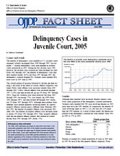 Delinquency Cases in Juvenile Court, 2005 (Fact Sheet)
Delinquency Cases in Juvenile Court, 2005 (Fact Sheet)
This Fact Sheet presents statistics on delinquency cases processed between 1985 and 2005 by U.S. courts with juvenile jurisdiction. The estimates are based on data from more than 2,100 courts with jurisdiction over 80 percent of the Nation's juvenile population (youth age 10 through the upper age of original juvenile court jurisdiction in each State). To order a printed copy, visit the NCJRS Web site.
 Delinquency Cases Waived to Criminal Court, 2005 (Fact Sheet)
Delinquency Cases Waived to Criminal Court, 2005 (Fact Sheet)
This Fact Sheet presents estimates of the number of cases transferred from juvenile court to criminal court through the judicial waiver mechanism between 1985 and 2005. The number of delinquency cases judicially waived peaked in 1994 at 13,000 cases. This represented an 80-percent increase over the number of cases waived in 1985 (7,200). Since 1994, however, the number of cases judicially waived declined 47 percent (6,900 cases in 2005).
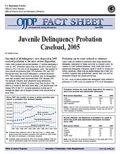 Juvenile Delinquency Probation Caseload, 2005 (Fact Sheet)
Juvenile Delinquency Probation Caseload, 2005 (Fact Sheet)
This Fact Sheet presents statistics on delinquency cases resulting in probation between 1985 and 2005. In 2005, courts with juvenile jurisdiction handled 1.7 million delinquency cases. Probation supervision was the most severe disposition in 33 percent of all delinquency cases. Between 1985 and 2005, the overall delinquency caseload increased 46 percent. The national estimates were generated using information contributed to the National Juvenile Court Data Archive.
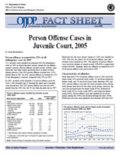 Person Offense Cases in Juvenile Court, 2005 (Fact Sheet)
Person Offense Cases in Juvenile Court, 2005 (Fact Sheet)
This Fact Sheet presents statistics on person offenses (assault, robbery, rape, and homicide) handled by juvenile courts between 1985 and 2005. In 2005, U.S. juvenile courts handled an estimated 429,500 delinquency cases in which the most serious charge was an offense against a person. The 2005 person offense caseload was 133 percent greater than in 1985. In 2005, person offenses accounted for 25 percent of the delinquency caseload, compared with 16 percent in 1985.
 Disproportionate Minority Contact Technical Assistance Manual
Disproportionate Minority Contact Technical Assistance Manual
Fourth Edition (Online Manual)
This online manual presents an overview of methods for calculating and analyzing disproportionate minority contact (DMC); outlines how jurisdictions can use data to facilitate decisionmaking; and reviews multidisciplinary and collaborative approaches for local communities, promising intervention strategies, performance measurement and evaluation, and Federal, State, and local partnerships. The fourth edition includes two new chapters—one on DMC data and intervention strategies for serving Hispanic youth in the juvenile justice system, and the other on the role of State DMC Coordinators.

The Coordinating Council on Juvenile Justice and Delinquency Prevention will announce its meeting schedule for 2009 once the dates and locations have been confirmed. For additional information on the Council, please visit its Web site.
The Council is comprised of 18 members, including 9 ex officio members—the Attorney General; the Secretaries of the Departments of Justice, Education, Health and Human Services, Housing and Urban Development, and Labor; the Assistant Secretary of Immigration and Customs Enforcement in the Department of Homeland Security; the Director of the Office of National Drug Control Policy; and the Chief Executive Officer of the Corporation for National and Community Service. An additional nine members are juvenile justice practitioners appointed by the Speaker of the House of Representatives, the Senate Majority Leader, and the President of the United States.
 The Federal Advisory Committee on Juvenile Justice (FACJJ) Annual Report Subcommittee convened its 2009 Summer Meeting July 29–30 in St. Louis, MO. The subcommittee compiled results from the recent annual request for information, which will be featured in the 2010 FACJJ Annual Report. The annual request for information is an informal survey that allows each State and territory to express ideas, concerns, opinions, and recommendations on juvenile justice issues.
The Federal Advisory Committee on Juvenile Justice (FACJJ) Annual Report Subcommittee convened its 2009 Summer Meeting July 29–30 in St. Louis, MO. The subcommittee compiled results from the recent annual request for information, which will be featured in the 2010 FACJJ Annual Report. The annual request for information is an informal survey that allows each State and territory to express ideas, concerns, opinions, and recommendations on juvenile justice issues.
FACJJ's 2009 Fall Meeting will be held October 29–31 in Austin, TX. Registration is available through FACJJ's meeting registration Web site.

Western New England College President Anthony S. Caprio awards the President's Medallion to Ron Laney, Associate Administrator of OJJDP's Child Protection Division.
Last year, Mr. Laney received a distinguished service award from the American Professional Society on the Abuse of Children (APSAC).
